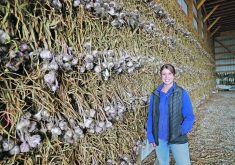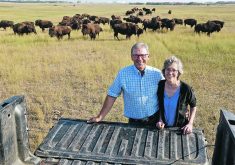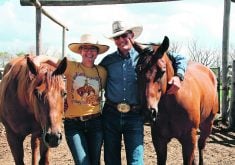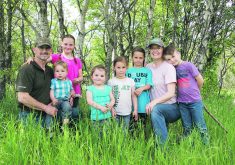Small farmer plants nut trees, sells pine trees at Christmas and holds classes on willow weaving to make farm pay
KELOWNA, B.C. — At the end of May, Brenda Dureault was busy germinating paw-paw seeds to plant as trees on her Kelowna area farm.
She owns Curly Frog Farm, where she has converted a rundown piece of property into a tree farm. She grows black walnuts, chestnuts, mulberries and other native tree varieties like dogwood, willows and cottonwoods.
A single mother of five, she moved to the farm in 2000 and bought it in 2009. Her father was a developer and owned the unserviced 26 acres but never farmed it.
Read Also

Know what costs are involved in keeping crops in the bin
When you’re looking at full bins and rising calf prices, the human reflex is to hold on and hope for more. That’s not a plan. It’s a bet. Storage has a price tag.
A former nurse, she farms full time and has made a Herculean effort to upgrade the farm with its special challenges.
A creek runs through the property and she was told it might flood every 11 years. Paved over industrial development and the death of trees on the hillsides due to the mountain pine beetle cannot stop the flow of water.
“This year, we have flooded twice already,” she said.
“It makes it challenging to farm.”
In the early years, she did not have much money so she collected cuttings and seeds to start a planting program where thousands of trees have gone into the ground to use excess moisture.
“I started looking at a different way to farm. I started doing a lot of research and online courses on permaculture and talked to the ministry of agriculture and forests, anybody who would have information about what I could farm on a high water table,” she said.
“I didn’t want to grow 26 acres of celery. That’s what I was told to farm but that is too much work for one person.”
The ministry of forests suggested trying black walnuts developed at Purdue University. They are native to the Niagara region in Ontario so she was sure they would grow well in her area.
She germinated seeds and planted the first rows in 2009-10. They have long taproots and draw up plenty of water. There are about 300 now and they are bearing more nuts each year.
Black walnuts have a harder shell and a stronger flavour than the traditional ones. The trees also produce hardwood timber and support wildlife.
Mulberries, which are nearby as companion plants, are bearing fruit this year. Among the plantings, there are also miniature chestnuts and pine trees to sell at Christmas.
There is little information about growing or marketing nuts so she volunteered at the Gellatly Nut Farm run by the regional district at Westside. She also worked in a greenhouse to learn more.
“You learn by doing because there isn’t a lot of information on these crops,” she said.
The ground is soggy, but she still needs a licence to irrigate to cope with the hot dry Okanagan summers.
“We are definitely unique in the Okanagan, where we suffer the drought desert conditions in the summer but then we have got this condition in the spring,” she said.
“I am hoping this is the answer and if it is, I think there are a lot of farms that could be modelled after that.”
During the summer, she plants vegetables in the worked up areas around the trees.
Besides agri-forestry, she has developed seven acres of wetland on one side of the farm. It provides ecogoods and services but there is little financial support for what many consider to be a societal benefit.
A door to the wetland opens into a space that looks like an Alice in Wonderland adventure land. Pathways cut past hundreds of willows and birds like herons, killdeer, ducks, geese and blackbirds are thriving.
There are also some invasive plants that she keeps an eye on to prevent from spreading.
Tours are available for children or birdwatchers.
A skilled weaver, she also offers classes at local colleges on willow weaving. Throughout the farm, she has built chairs and benches and trained willows to grow around them.
Last year in a wetlands co-operative project with the B.C. Wildlife Federation, a crew of 30 showed up to build chinampas to increase the farmable acres.
Two ponds were excavated and the soil became raised strips of land away from the water where she can plant paw paws. Native plants, rocks and old tree stumps were placed around the ponds to create habitat for birds, turtles and other wildlife.
“I learned about this through researching how to farm high water table areas and that is what the ancient Aztecs used to do,” she said.
When she was a nurse on night shifts, she was tired and stressed out. She was raising children and time was always at a premium. The children have moved on although her son, who is a mechanic, is nearby and can help with repairs, while her daughters are travelling and getting ready for university.
“This to me isn’t work. This is something I love,” she said.
The farm is also at the point where she either needs to hire help or form a joint venture with someone to find new ways to earn a living.
“There has to be a way to make farms pay, especially when you don’t have the land base for scale, so you have to do direct marketing and you have to do something niche.”
















